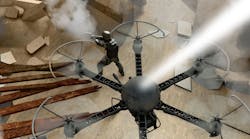Unmanned aerial vehicles (UAVs) or drones represent a growing threat for all branches of the military, since they can carry significant armaments and be programmed to attack from a distance. But they can be defeated, as the U. S. Air Force recently demonstrated during an exercise at White Sands Missile Range, N.M., using high-power microwave and high-energy laser systems developed by Raytheon Co. The high-power systems emitted bursts of the two forms of energy to defeat dozens of drone targets.
The defense systems used transmitted microwave signals and laser beams to disrupt the guidance systems in the UAVs during the exercise, bringing down dozens of small drones (see figure). Target drones were flying both alone and in swarms. Both the high-power microwave (HPM) and high-energy laser (HEL) systems are mobile designs that can be installed on all-terrain military vehicles for ease of transport. The microwave and laser systems used in the exercise were not difficult to use—airmen took control of both systems after only one day of training. They used command interfaces very similar to the X-Box video game units and joystick control manufactured by Microsoft.
HEL and HPM directed-energy systems can be mounted on military all-terrain vehicles for mobile defense against enemy drones. (Courtesy of Raytheon Co.)
The demonstration, which involved only directed-energy weapons from Raytheon, was part of the Air Force Directed Energy Experimentation campaign. The two systems are designed to complement each other. The HPM system can defeat a swarm of drones while the HEL can shoot down drones one at a time. If the laser system is occupied and another drone is attacking, the HPM system can be used to defeat the drone. Dr. Thomas Bussing, Raytheon Advanced Missile Systems vice president, explains, “After decades of research and investment, we believe these advanced directed energy applications will soon be ready for the battlefield.”


